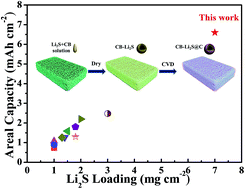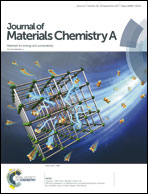A 3D conductive network with high loading Li2S@C for high performance lithium–sulfur batteries†
Abstract
Construction of novel cathodes with a high loading of active material and excellent confinement effect for polysulfides is indispensable and vital for the realization of high-energy and commercially viable lithium–sulfur batteries. In this study, we demonstrated a facile strategy for the fabrication of an integrated lithium sulfide (Li2S) cathode by incorporating lithium sulfide (Li2S)/carbon black (CB) into the carbon felt (CF) with a 3D conductive network and further modifying it by an outer amorphous carbon shell (CF–CB–Li2S@C) via facile liquid solution-evaporation plus chemical vapor deposition technologies. The CF with abundant macroporous channels provides enough reaction sites to load and stabilize a high amount of active materials. The inter-connected conductive network and efficient carbon shell not only provide efficient electron transport and guarantee high active material utilization, but also form a durable protective shield for suppressing polysulfide dissolution. As a result, the CF–CB–Li2S@C cathode with a high loading of 7 mg cm−2 demonstrates an initial discharge capacity of 943.7 mA h g−1 (6.60 mA h cm−2) at 0.1C. Importantly, it still maintains a capacity of 567.5 mA h g−1 (3.97 mA h cm−2) at 1C after 200 cycles, corresponding to a low fading rate of 0.12% per cycle.



 Please wait while we load your content...
Please wait while we load your content...